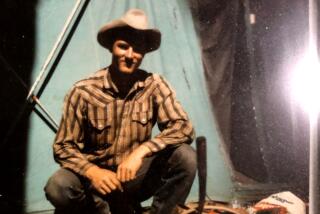A north woods summer unfolds
- Share via
Jim BRANDENBURG is the photographer who took that widely seen shot of the lone wolf, hopping from one chunk of ice to another, somewhere up in the Arctic Circle. He’s also the one who, feeling burned out on the business after years of high-powered global assignments, retreated to his home in Minnesota’s north woods.
There he consoled himself and dug deeper into his craft by shooting a single photo every day for an entire autumn -- 90 images of the natural world so striking that National Geographic ran them all in 1997. Brandenburg went on to release the images as a remarkable book, “Chased by the Light” (NorthWord), in 1998.
“I was driven in and out of dark emotional places,” he writes in the new book, “to recapture what I thought was lost in my art and a small but important part of my life -- an intimate and long-lasting relationship with the land.”
Brandenburg has revisited that formula, this time with sunnier intentions. As his introduction spells out, he’s a happier guy, having shot his way through a midlife crisis, and he has set himself a summer shooting schedule this time.
He’s also setting looser restrictions on himself (spending as much film as needed each day to get a favorite image), but the result is similar: a meditation on the season, a love song to the region and an achievement to daunt and inspire any photo hobbyist.
Maybe because we know a bit of the story behind them or maybe just because fall is a heavier season than summer, Brandenburg’s autumn images seem to carry more heft. But these 94 glimpses suggest that the light, bright world of backwoods Minnesota in summer is still a marvelous place.
Day 1 brings an extreme close-up of a wild rose, in pinks and yellows that might have made Georgia O’Keeffe blush. Day 3 is green grass, just as close. On Day 8 we glimpse a hare, on Day 17 a great blue heron atop an evergreen in thick mist. Day 20 brings bear cubs, Day 27 a turtle. And so we go through the pebbles, leaves and sunsets, to a sort of circling surprise ending, of which I will say only that it involves rocks and a fox.
Adventure, Alaska and ambivalence
The Let’s Go series is still a kid at 43, relying as ever on Harvard students as its eyes and ears. This guide, in its first edition, seems a mostly happy marriage of eyes, ears and content. Good maps, liberally sprinkled, are matched with a helpful design that puts key nouns in boldface. Nobody else’s book has ever made me curious about the Ice Worm Festival in Cordova every February. (See Page 301; they crown a queen!) And my memory of the tasty, bohemian Two Sisters Bakery in Homer (Page 168) matches the Let’s Go view. Another good detail: Unlike most guidebook editors, these guys say upfront exactly when this information was gathered (May to August 2003).
There is a little identity crisis here, though. In the Homer pages, the editors note that hitchhiking is easy on the Sterling Highway, then turn around and say, “ ‘Let’s Go’ doesn’t recommend it.” Similarly, those editors note that marijuana from the Matanuska Valley is “incredibly potent” and label it the “second best way to get high” in Alaska. (Climbing Mt. McKinley is first.) Then they turn around and says Let’s Go “does not endorse using illegal substances for recreation.” I say, either get all the way on board for hitchhiking and dope-smoking (and face the consequences) or all the way off.
Books to Go appears monthly.
More to Read
Sign up for our Book Club newsletter
Get the latest news, events and more from the Los Angeles Times Book Club, and help us get L.A. reading and talking.
You may occasionally receive promotional content from the Los Angeles Times.











